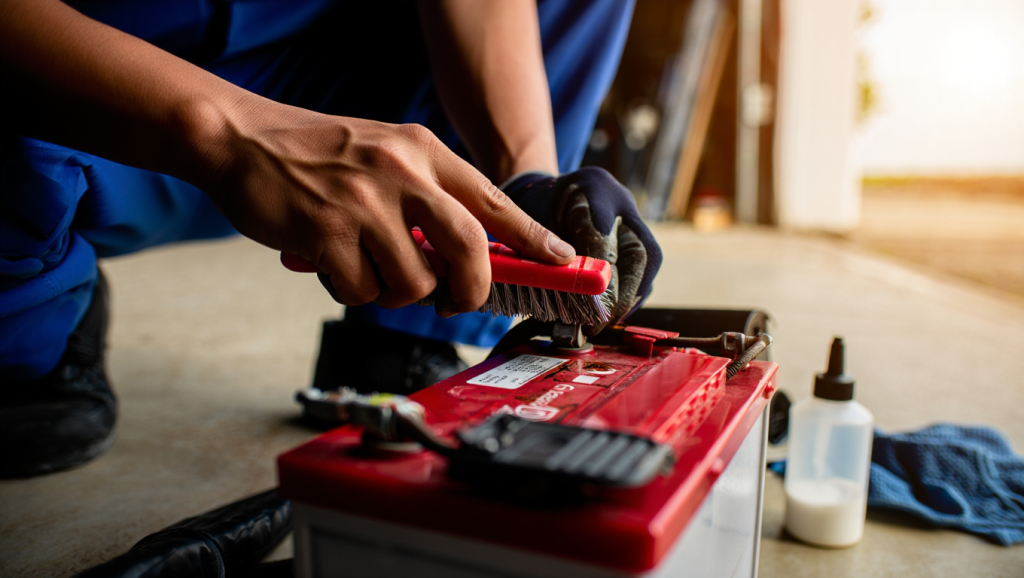Your car’s battery is the silent powerhouse under the hood. Without it, you wouldn’t be able to start your engine, run your headlights at night, or even power the radio. A weak or neglected battery can leave you stranded at the worst possible time and lead to an expensive replacement bill.
The good news is that with proper care, you can extend your car battery’s lifespan by several years. From keeping corrosion under control to understanding when it’s time for replacement, smart maintenance habits can save you both money and headaches.
In this guide, I’ll walk you through the most practical battery maintenance tips, common mistakes to avoid, cost considerations, and expert tricks that can keep your battery running strong.
Understanding Your Car Battery
Before diving into maintenance, it’s important to understand what a car battery does and how long you can expect it to last.
How a Car Battery Works
Most vehicles today use lead-acid batteries or AGM (Absorbent Glass Mat) batteries. Lead-acid batteries are the traditional, more affordable type, while AGM batteries are designed for modern vehicles with heavy electrical loads, such as infotainment systems, heated seats, and start-stop technology.
The battery’s primary job is to provide a burst of electrical energy to start the engine. Once the car is running, the alternator takes over, powering electrical systems and recharging the battery. Think of the battery as a reservoir—it stores energy for the critical moment when you turn the key or press the start button.
Average Lifespan of a Car Battery
On average, a car battery lasts 3 to 5 years. However, lifespan can vary widely depending on your driving habits, climate, and battery type. For example:
- In hot climates like Arizona or Texas, heat can shorten a battery’s life to just 2–3 years.
- In cold climates, chemical reactions slow down, making starts harder but often extending lifespan to 5 years if maintained properly.
Signs your battery is nearing its end include: slow cranking, dimming headlights, electrical glitches, or the dreaded check battery warning light. If you notice swelling, leaking, or a rotten egg smell, replacement is overdue.
Essential Car Battery Maintenance Tips
Proper maintenance can add months—or even years—to your car battery’s life. Here’s how to keep it in peak condition.
Keep Terminals Clean and Corrosion-Free
Corrosion is the number-one enemy of healthy battery connections. It happens when sulfuric acid vapors escape and react with metal terminals, forming a crusty white or bluish buildup.
How to clean corrosion safely:
- Disconnect the negative cable first, then the positive.
- Mix baking soda with water and scrub the terminals with a wire brush.
- Rinse with clean water and dry thoroughly.
- Apply petroleum jelly or a terminal protector spray to prevent future buildup.
Skipping this step is one of the most common mistakes car owners make. Corroded terminals lead to weak starts, flickering lights, and voltage drops.
Check Battery Fluid and Electrolyte Levels (for Serviceable Batteries)
Many modern batteries are sealed, but some older lead-acid batteries allow you to check electrolyte levels. Low fluid exposes the lead plates, leading to sulfation and premature failure.
- Only use distilled water to top off cells. Tap water contains minerals that damage the plates.
- Wear safety glasses and gloves when checking—battery acid can cause serious burns.
This simple step can add months of life to a battery that might otherwise fail early.
Ensure a Secure Battery Connection
Loose clamps or cables might not seem like a big deal, but they can cause voltage fluctuations, intermittent starting problems, and even damage to sensitive electronics.
Always make sure the battery is snugly secured in its tray and that terminals are tightened properly. A rattling or bouncing battery can crack its case over time—something we see often in older vehicles that drive on rough roads.
Protect Against Extreme Temperatures
Batteries hate temperature extremes:
- Heat speeds up water evaporation inside the battery, leading to dry cells and plate damage.
- Cold slows chemical reactions, making it harder to start your car.
Seasonal tips:
- In hot weather, park in the shade whenever possible.
- In freezing climates, consider an insulated battery blanket or garage parking.
- Some manufacturers sell OEM thermal covers designed to keep batteries at stable temperatures.
Drive Regularly to Keep It Charged
Short trips are brutal on a battery. If you only drive five minutes to work and back, your alternator doesn’t have enough time to recharge the battery fully. Over time, this leads to sulfation and reduced capacity.
Best practices:
- Drive at least 20–30 minutes once a week.
- If you don’t drive often, invest in a trickle charger or battery maintainer. Aftermarket maintainers from brands like NOCO or Battery Tender can cost $30–$60 and save you from a premature replacement.
Minimize Parasitic Drains
Even when the car is off, certain systems—like alarms, dash cams, or phone chargers—may keep drawing power. This is called a parasitic drain.
To reduce it:
- Unplug chargers when not in use.
- Turn off aftermarket devices.
- If you suspect a drain, have a mechanic test the current draw with a multimeter.
Buyer-Intent Considerations for Car Batteries
At some point, even the best-maintained battery will need replacing. Here’s what you should know before buying.
When to Replace vs. Maintain
You can clean terminals and top off fluids, but you can’t reverse chemical wear. Replace your battery if you see:
- A swollen case (often from heat or overcharging).
- Leaking acid.
- Dead cells after load testing.
Maintenance can help prolong life, but once a battery fails these tests, replacement is the only safe option.
Cost of Replacement Batteries
Car battery costs vary depending on type:
- Standard Lead-Acid: $80–$150 (budget-friendly, shorter lifespan).
- AGM Batteries: $150–$250 (great for modern vehicles with electronics).
- Lithium Batteries: $300–$500+ (lightweight, long lifespan, mostly for performance cars).
OEM vs. Aftermarket:
- OEM batteries are built to factory specs and often last longer, but they cost more.
- Aftermarket options can be cheaper and offer higher cold cranking amps (CCA), but quality varies by brand.
Battery Warranty and Lifespan
Most car batteries come with a 2- to 5-year warranty. Warranties usually cover early defects but not misuse or neglect. For example, if your alternator overcharges and fries the battery, the warranty may not apply.
Keeping up with maintenance—checking voltage, securing connections, and preventing deep discharges—can ensure you don’t void coverage.
Common Mistakes Car Owners Make
Ignoring Corrosion Until It’s Too Late

By the time corrosion builds up enough to block current, your battery may already be damaged. Cleaning once or twice a year prevents this.
Jump-Starting Incorrectly (and Damaging Electronics)
Hooking cables backward or skipping a surge protector can fry sensitive electronics. Always connect positive to positive, negative to ground, and disconnect in reverse order.
Letting the Car Sit for Weeks Without Charging
A parked car can drain its battery in as little as 2–3 weeks, especially with alarms and sensors running. Use a maintainer if you travel often.
Overfilling or Using Tap Water in Serviceable Batteries
Adding too much water causes overflow and corrosion, while tap water introduces minerals that destroy internal plates. Always stick to distilled water.
Practical Pro Tips for Longer Battery Life
Invest in a Battery Maintainer if You Don’t Drive Often
For seasonal vehicles like RVs, classic cars, or motorcycles, a maintainer is a must-have. It keeps the charge level steady without overcharging.
Check Charging System (Alternator & Voltage Regulator Health)
A weak alternator won’t recharge your battery properly, while a faulty regulator can overcharge and boil it dry. Regular charging system checks can prevent battery “mystery deaths.”
Perform Load Testing During Routine Service
A simple load test at the shop can reveal whether your battery is holding capacity. Many parts stores offer this service for free.
Park in Covered or Temperature-Controlled Areas
Something as simple as garage parking can extend your battery’s life by shielding it from extreme hot or cold.
Conclusion
Your car battery is a vital component that deserves regular attention. By keeping terminals clean, driving regularly, preventing drains, and protecting against extreme temperatures, you can significantly extend its lifespan and avoid sudden failures.
Smart habits like routine checks and investing in a battery maintainer cost little but save you from the hassle of an untimely breakdown. If your battery shows signs of weakness, don’t wait until it fails—get it tested or replaced.
FAQs
How often should I check my car battery?
Check your battery every 3–4 months for corrosion, fluid levels, and voltage health. More frequent checks are recommended in extreme climates. Regular inspections catch small problems before they leave you stranded.
What’s the best way to clean battery corrosion safely?
Mix baking soda and water to neutralize acid, scrub with a wire brush, rinse, and dry. Always disconnect the negative terminal first and wear gloves and safety glasses to avoid acid burns.
Can I use tap water instead of distilled water?
No. Tap water contains minerals that corrode the plates inside the battery, reducing lifespan. Distilled water is free from minerals and safe for topping off fluid levels in serviceable batteries. Always use distilled water only.
How do I know if my alternator is killing my battery?
If your battery keeps dying, test voltage while the engine runs. A healthy alternator produces 13.5–14.7 volts. Too high indicates overcharging; too low means undercharging. Mechanics can confirm with a charging system test.
Is it okay to use a higher CCA (cold cranking amps) battery than recommended?
Yes, using a battery with higher CCA is generally safe and can improve cold-weather starts. The key is to match the physical size and terminal layout to your vehicle’s requirements. Avoid going lower than the recommended rating.
Should I disconnect the battery if storing my car long-term?
Yes, disconnecting prevents parasitic drains. For best results, connect the battery to a maintainer while in storage. This keeps it fully charged and ready for use when you return.
Does idling recharge a battery as well as driving?
Not really. Idling produces minimal alternator output and may not fully recharge a drained battery. Driving at normal speeds for 20–30 minutes is far more effective. Use a charger if your battery is deeply discharged.

Benjamin Grey is an automotive engineer and writer at Car Parts Advisor. With years of experience in the automotive industry, he shares expert advice on car parts, maintenance, and repairs to help car owners keep their vehicles running smoothly.





